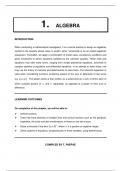College aantekeningen
Lecture notes ENGINEERING COURSES (MATE1A1)
- Vak
- Instelling
This material will provide you with knowledge of calculus which is used in engineering practices and its of higher education and recommended by qualified lecturers.
[Meer zien]




